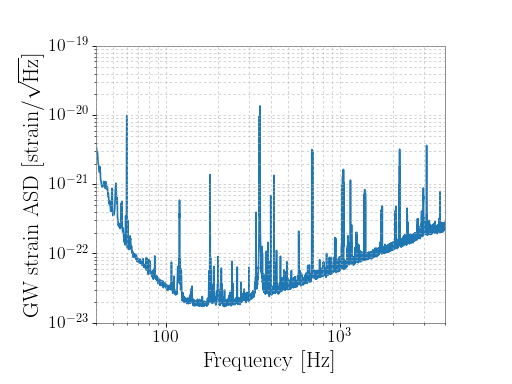The FrequencySeries¶
While gravitational-wave detectors are time-domain instruments, their sensitivity is frequency dependent and so is often measured as a power-spectral-density over the range of interesting gravitational-wave frequencies (~10-10,000 Hz). Additionally, the auxiliary channels used to sense and control instrumental operations each have their own frequency-domain characteristics, contributing to the overall sensitivity spectrum.
The FrequencySeries object is used to represent any frequency series, including the power-spectral (and amplitude-spectral) density series describing instrument performance.
Analogously to the TimeSeries, a new FrequencySeries can be generated from any data sequence along with the minimal f0 and df metadata:
>>> from gwpy.frequencyseries import FrequencySeries
>>> spec = FrequencySeries([1,2,3,4,5,6,7,8,9,10], f0=0, df=1)
>>> print(spec)
FrequencySeries([ 1 2 3 4 5 6 7 8 9 10],
name: None,
unit: None,
epoch: None,
channel: None,
f0: 0 Hz,
df: 1 Hz,
logf: False)
The full set of metadata that can be provided is as follows:
name |
Name for this data set |
unit |
The physical unit of these data |
epoch |
GPS epoch associated with these data |
f0 |
Starting frequency for this FrequencySeries |
df |
Frequency spacing of this FrequencySeries |
Generating a FrequencySeries from a TimeSeries¶
The frequency-spectrum of a TimeSeries can be calculated using either of the following methods:
TimeSeries.psd |
Calculate the PSD FrequencySeries for this TimeSeries |
TimeSeries.asd |
Calculate the ASD FrequencySeries of this TimeSeries |
In this example we expand upon plotting a TimeSeries, by calculating the amplitude-spectral density of the gravitational-wave strain data from LHO:
from gwpy.timeseries import TimeSeries
gwdata = TimeSeries.fetch('H1:LDAS-STRAIN', 'September 16 2010 06:40', 'September 16 2010 06:50')
spectrum = gwdata.asd(8, 4)
where the result is an average spectrum calculated using the Welch method.
Reading/writing frequency-domain data¶
Plotting a FrequencySeries¶
Similary to the TimeSeries, the FrequencySeries object comes with its own plot() method, which will quickly construct a FrequencySeriesPlot:
from gwpy.timeseries import TimeSeries
gwdata = TimeSeries.fetch('H1:LDAS-STRAIN', 'September 16 2010 06:40', 'September 16 2010 06:50')
spectrum = gwdata.asd(8, 4)
plot = spectrum.plot()
ax = plot.gca()
ax.set_xlim(40, 4000)
ax.set_ylabel(r'GW strain ASD [strain$/\sqrt{\mathrm{Hz}}$]')
ax.set_ylim(1e-23, 1e-19)
plot.show()
(png)

FrequencySeries applications¶
FrequencySeries reference¶
FrequencySeries |
A data array holding some metadata to represent a frequency series |
SpectralVariance |
A 2-dimensional array containing the variance histogram of a |